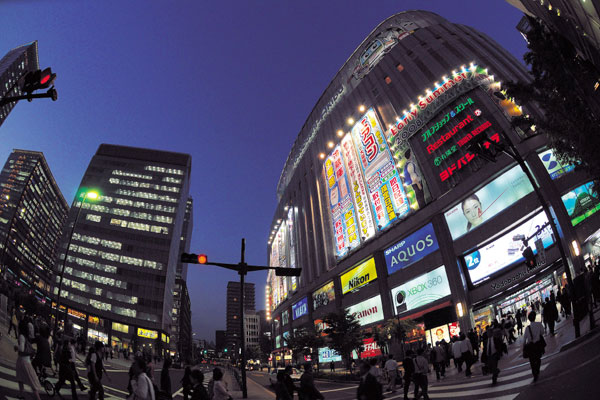Special Feature![]() Exploring Akihabara, Japan’s Electronic Market
Exploring Akihabara, Japan’s Electronic Market
The Ultimate in Shopping for Electronics
Just about everything in the electric and electronic world is sold in Akihabara. Geeks come looking for specialty goods, tourists from overseas for souvenirs, families for the latest home appliances—and the nice thing is that they all go home happy with what they bought.
Written by Takahashi Koki Photos by Onishi Mitsugu

Facade of Yodobashi Camera Multimedia Akiba, near the East Exit of Akihabara Station. With a total retail floor area of 23,800 square meters, it is one of the largest stores in Japan selling electric and electronic goods.
A Gigantic Maze of Electronic Goods
Akihabara “Electric City,” with all its stores selling so many products, is smaller than you might think—only about 400 meters east-west, 600 meters north-south. Much of it is located on the west side of JR’s Akihabara Station. It takes only about 10 minutes to walk from the north end to the south along Chuo-dori, the main street bisecting the area. But size is deceiving—it would take a whole day, or even two, to see all the goods and gadgets on display, many of them at bargain prices.
The maze got bigger in September 2005 when the colossal Yodobashi Camera Multimedia Akiba store opened near the station’s east exit. From the outside the building looks something like a towering space ship, but inside, from the first to the sixth floors, stand displays of electric and electronic goods, computers, software, cell phones, video games, toys and much more with the minimum of space between them.
“Every product model we sell has to be on display. That includes all of the many peripherals and computing accessories we stock,” explains a member of the Yodobashi Camera store staff.
It would take over an hour to examine everything on each of the six retail floors. You may want to spend the whole day inside—when you get hungry, try one of the restaurants on the 8th floor of the building.
A Shift Toward High-tech Electronic and Tax-free Goods
Tens of thousands of customers visit the new Yodobashi Camera store every weekday. The older, more established stores cannot rest on their reputations, and are protecting themselves in a number of ways. Some now concentrate on high-tech electronic goods, and have knowledgeable staff to explain technical details to customers. Others have increased tax-free shopping options for foreign visitors.
About 20 stores, mostly near the station’s west side, do not charge Japan’s 5% sales tax to eligible international customers. Some staff give detailed explanations in English, Chinese or Korean, or perhaps Spanish, Portuguese, or French. At LaOX Duty Free Akihabara, an immense store with a full range of electric and electronic goods, the hottest items just a while ago were digital cameras, video cameras and timepieces, but the best-sellers are now cosmetics, and cookers for the long-grain rice eaten in other parts of Asia.